Interface Details
The main GUI Editor view consists of 5 primary sections:
File MenuFound at the very top, this is where you will find various menus that controls global functionality of the editor, such as creating/saving GUI files, manually locking, selecting, and aligning controls, toggle snapping, and so on.The ToolbarLocated just below the File Menu, this bar contains shortcuts to the GUI Selector, resolution adjuster, and common positioning actions (nudge, align, etc).Control PaletteThe Control Palette contains all of the controls you can add to your current GUI. You can click a control in the list or manually drag it to a position in the view to add it to the scene.GUI Tree PanelThis panel, located on the far right, contains all of the controls that make up your current GUI. They are listed in hierarchical tree, which is sorted by oldest to most recent (top to bottom) and parenting (described later).GUI Inspector PanelThis panel, found directly below the GUI Tree Panel, is populated with all the properties that make up the currently selected GUI control. Most of your field editing will be performed here.
File Menu
File Menu allows you to create, save, and open GUI files. You can also revert GUIs or load from file.
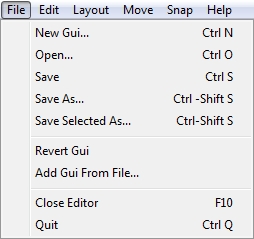
The Edit Menu controls various editor actions, such as undo and redo. The second function allows you to cut/copy/paste/delete objects you have selected. Finally, this is the menu that allows you to perform selection and group actions, such as toggling visibility and locking.
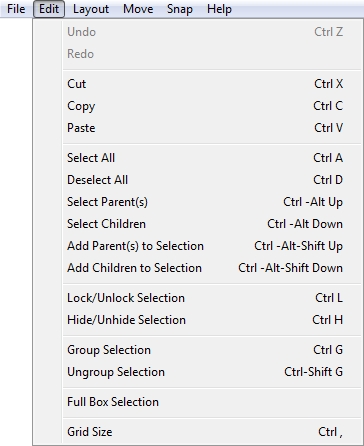
The Layout Menu contains actions that makes it easy for you align your GUI controls for a clean and neat appearance. This is very useful for a complex interface with multiple controls that stack vertically or horizontally.
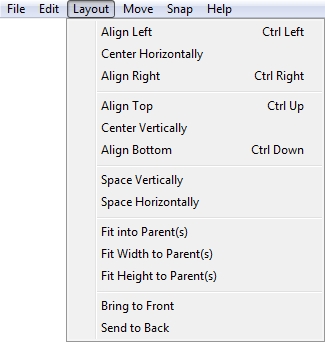
When you need to perform very subtle and precise movements on a GUI control, you can use the actions listed in the Move Menu. Each nudge is assigned a shortcut, so using this menu is optional.
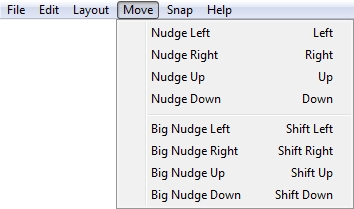
When dragging GUI controls with your mouse, using the Snap Menu toggles will cause your mouse to immediately jump to specific points (depending on the toggle).

Contains shortcuts to documentation and forums for Torque 3D.

Tool Bar
The most useful and preferred shortcuts for quick edits can be found in the Tool Bar. While most of your control properties will be edited in the Inspector, you can use the Tool Bar to perform quick positioning actions and testing.
![]()
The first three icons toggle the editors, and are always available. The left most icon (looks like a mountain) toggles the World Editor. The next one (boxes) toggles the GUI Editor. The Play icon will exit the editors and let you play through the game.
Next to the editor toggles, you will find three extremely important settings. The first two are drop down lists and the last one is a button toggle. These determine what you are editing and at what resolution. The first drop down is a list of every single GUI available to edit, including new ones you just created. You can jump to an individual GUI at anytime, which can be useful if you are editing multiple GUIs that which work together. The second drop down list contains three different resolutions you can build your GUI in.
The button toggles the Control Palette, which is explained in the next section. The next set of icons allow you to toggle the most commonly used and important settings for snapping. After the snapping icons, several shortcuts are available toggle the alignment of controls. The next two icons, which look like multiple boxes attached to lines, are used when you have multiple GUI controls selected. These distribution toggles will equally space the GUIs you currently have selected. The final two icons in the the Tool Bar can move the currently selected GUI between layers. The first button will move the selected GUI ahead in a layer, bringing it closer to view. The second button will start shoving your GUI behind others, obscuring it from view.
Control Palette
The Control Palette contains all of the controls you can add to your current GUI. You can click a control in the list or manually drag it to a position in the view to add it to the scene. There are ways to view the list of available controls, depending on which tab you are using.
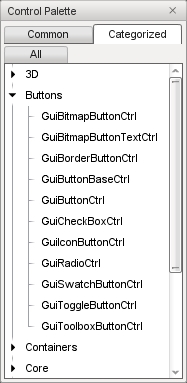
When you first toggle the Control Palette, you will see a list of the most commonly used controls. There are quite a few controls hidden, which are mainly used to create the Torque 3D editors. These controls are not typically used in games, so they have been hidden. You can click the All button to see every GUI control the engine contains. When you click on the Categorized tab, you can get list of all the GUI controls based on their functionality. The categories are straight forward and should be an excellent way to get to the exact controls you need to build your interface. To see what a category contains, just click on one of the arrows or text to expand it:
To add a control, locate it in the Palette’s list. Next, click on the control and drag it to your main view using a mouse. When you let go of your mouse button, you new control will anchor to the view and become your current selection.
GUI Tree View
Every control added to your current GUI is kept in a sorted list. To view this list, go to the panel on the far right and click the “GUI” tab. This will list all of your controls in the order they were added, the most recent at the bottom of the list. Each control has a unique ID, and can be given a name.
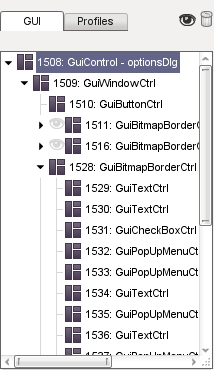
Profile Editor
In the same panel as the GUI Tree View, there is a tab called “Profiles.” Clicking this tab will present you with a list of all the GUI profiles currently loaded by your game. GUI profiles contain data that personalizes your controls. This will allow you tailor an interface unique to your game.
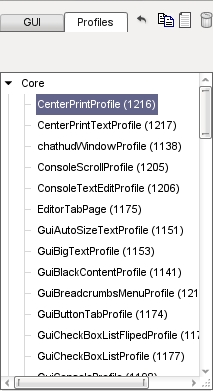
GUI Inspector
When you have a control or profile selected, the GUI inspector will be populated with the properties that make up the selection. These are the values that play an important role in assigning functionality to your GUI. Most of your editing will occur here.
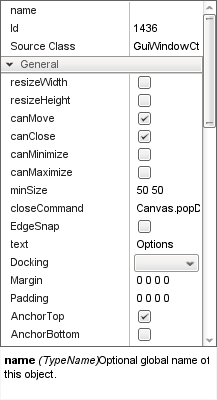
Selection and Parenting
The last portion of the interface is how controls are selected. The following image shows the stock options GUI that ships with Torque 3D. This consists of dozens of controls working together to make up the audio and video options:

In the above image, I have selected the list box control that shows the display driver for a video card. The current selection is marked by six boxes surrounding the corners of the control, and several subtle lines. However, you should notice there is a large blue box surrounding multiple controls.
The large blue box shows the Parent control. When a control is the “parent”, it can contain multiple sub-controls. The “children” controls will now adhere to the same behaviors as the parent control. For example, if the parent control is set to invisible, the children controls will become invisible as well. If the parent is moved, all the children controls will move with it.
Last updated